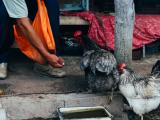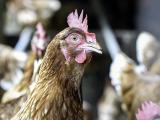Jan 13, 2009 (CIDRAP News) – A 21-month-old Egyptian girl has been hospitalized with an H5N1 avian influenza infection, the country's health ministry said yesterday.
The World Health Organization (WHO), in a statement posted yesterday on the Web site of its eastern Mediterranean office, said the girl's symptoms started on Jan 9 and she was admitted the next day to Imbaba Fever Hospital with fever, cough, vomiting, diarrhea, and rapid respiration. Her illness is listed as Egypt's 52nd H5N1 case.
The patient is from Kerdasa district, in 6th of October governorate on the western outskirts of Cairo. Her medical team immediately suspected avian influenza and treated the girl with oseltamivir (Tamiflu), 40 hours after the onset of her symptoms, according to the WHO report.
An investigation into the source of the girl's infection suggests that she had close contact with sick and dead poultry before she got sick, the WHO reported. The girl is recovering and is in good health.
Egypt reported its last human H5N1 case about 5 weeks ago, in a 16-year-old girl from Asyut governorate who died on Dec 15 after exposure to sick and dead poultry in her household, according to previous reports. The WHO listed the girl as Egypt's 51st case and its 23rd death.
Meanwhile, veterinary authorities in Egypt recently reported avian influenza outbreaks among backyard birds in two governorates, according to recent updates that appeared on the Egypt-based Strengthening Avian Influenza Detection and Response (SAIDR) Web site. SAIDR, a project funded by the US Agency for International Development with assistance from Johns Hopkins University, is designed to help Egypt coordinate avian flu efforts with its international partners.
One of the outbreaks, reported Dec 31, occurred in Fayoum governorate in central Egypt, where the virus struck 36 birds, including chickens, geese, and ducks that had been vaccinated in August 2008. The other outbreak, reported on Jan 9, occurred in Menofia governorate in northern Egypt, where the virus hit 34 previously vaccinated chickens and ducks.
The H5N1 virus is endemic in Egyptian poultry. The country's last report to the World Organization for Animal Health (OIE) in mid-June 2008 detailed an outbreak in backyard birds in Luxor governorate.
In other developments, health officials in China said yesterday that they had found no evidence in the wake of the recent death of a 19-year-old woman from an H5N1 infection that the virus has mutated to allow easier human-to-human transmission, according to a Reuters report yesterday. The report did not say where the genetic analysis of the virus was done and did not list any other details about the findings.
Mao Qunan, a health ministry spokesman, relayed the expert assessment to reporters at a news conference. He reminded the public to protect themselves from the virus but said they "should not have unnecessary fears," Reuters reported.
See also:
WHO eastern Mediterranean office Web site
Dec 16, 2008, CIDRAP News story "Egyptian teen dies of H5N1 infection"



















